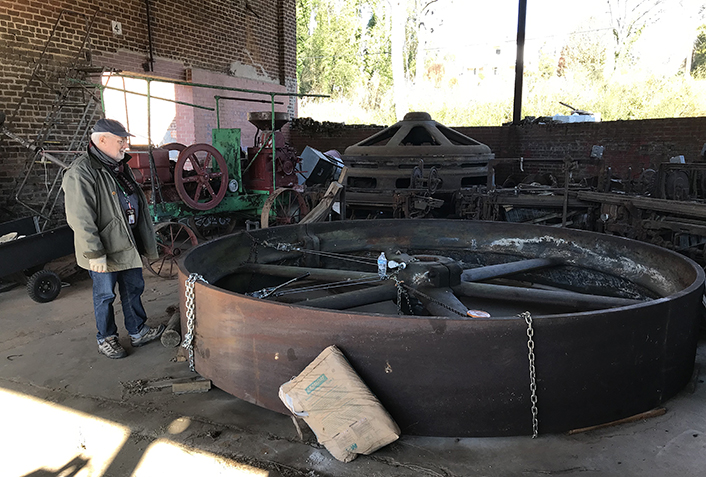Welcome!

Mac Whatley stands next to the steam engine wheel being restored at the site of the new North Carolina Textile Museum in Franklinville. Janet Imrick/Randolph Hub
Textile Museum aims for visible progress
Janet Imrick
Randolph Hub
FRANKLINVILLE — Replacing the roof at the Cedar Falls Textile Mill was a critical step toward the opening of the new North Carolina Textile Museum. That cost roughly $600,000 from a grant to the Randolph Heritage Conservancy.
However, Town Commissioner and Heritage Founder Mac Whatley said it left the citizens of Franklinville wanting more. They want to see progress, he said, and the rooftop was out of sight, out of mind.
Whatley and Site Manager Joe Lyons shifted focus to their workshop directly across from Franklinville’s Upper Mill along Bush Creek.
"I could do tours [at Cedar Falls],” Whatley said, “but a lot of people would just see the rust, the mildew on the leather. The plan is next summer to have over there [at the Upper Mill], that little room with stuff working."
Lyons is restoring machinery so that visitors can see how the textile mill used to operate. Before Thanksgiving, he opened up the original floor of the 1897 engine house. The two-foot-thick granite slabs that anchored the engine are still in good condition.
"There's nothing small about that steam engine," he said while holding one of the steam engine’s screws, roughly the length of his forearm.
Whatley is also using the Randolph Heritage Conservancy website randolphheritage.org for residents to follow the progress. Randolph Heritage serves as a private-public partnership to fund the restoration.
At the Upper Mill, they’ll spend this winter working on weatherproofing. "This room right here was probably knee deep in just rolls and rolls of yarn, a dumpster full," Lyons said. "Probably $100,000 worth of yarn, but it had gotten wet, and there was nothing we could do with it."
"There's smaller projects going on all over, that we're trying to take little bites out of," Whatley said.
Their plan is to have operational machinery running off a line shaft with volunteers doing live demonstrations at the Upper Mill, while Cedar Falls will be home to stationary exhibits and displays.
Whatley said their next big project at Cedar Falls is building a new main entrance across from the parking lot, so that visitors do not have walk to the loading dock door.
Randolph Heritage Conservancy got hundreds of machines from the American Textile History Museum in Lowell, Massachusetts.
Whatley compared the Cedar Falls interior to the warehouse at the end of "The Raiders of the Lost Ark." A spinning jenny from the 1790s sits on a shelf. On the floor sits a longer, more powerful loom for weaving king-size bedspreads. Another loom contains horse hair, used for upholstery.
They have patterns for hooked rugs from Waynesville and boxes full of Scalamandré sample books. There are machines from the Whitin Company, one of the industry’s biggest manufacturers at one time.
"I would say the Eastern Seaboard is well represented," Whatley said. "The major difference would be a lot of mills in New England were woolen mills because that's where the sheep were. We actually have more woolen machinery than cotton machinery because collections up there came from New England. But we have plenty of cotton machinery from North Carolina."
He estimates all their equipment may have come from 15 to 20 states.
“The ingenuity in this kind of machinery is what intrigues me,” Whatley said. “That's why I think it's worth preserving. Every one of these is an engineering miracle."
Whatley will spend 2025 looking for more funding and grant opportunities, now that Cedar Falls’ roof restoration is done. The mills need sprinklers before they can get an occupancy rating, which might cost at least $100,000. In the meantime, he hopes he can give more people a look at the work, so that they can appreciate what's coming to Franklinville.
He's made a goal to have enough ready for hosting smaller events in May, which is Historic Preservation Month.
